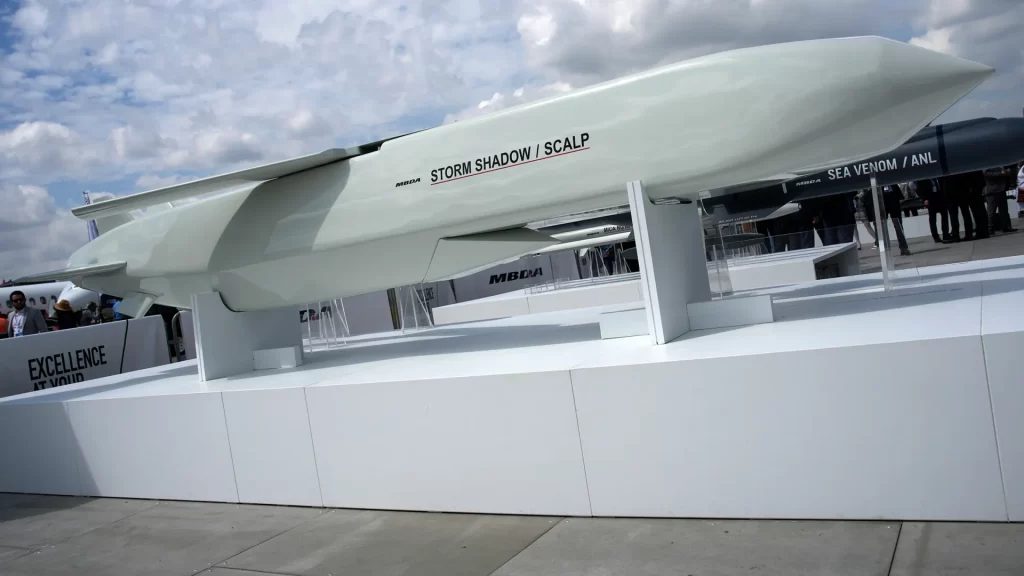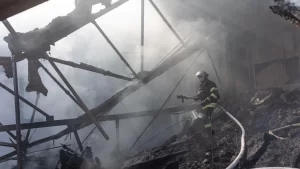
Recent reports suggest that the United States and the United Kingdom may soon lift their restrictions on Ukraine’s use of long-range missiles against targets within Russia. Although Ukraine currently possesses Storm Shadow missiles, it is only permitted to deploy them within its own borders. Kyiv has been urgently advocating for these restrictions to be removed, seeking the capability to target Russian military installations beyond the Ukrainian front lines. But what makes Storm Shadow missiles significant, and why has the West hesitated to fully support their deployment?
Understanding Storm Shadow Missiles
The Storm Shadow, known as Scalp in France, is a long-range cruise missile developed through a collaboration between the UK and France. It boasts a maximum range of approximately 250 kilometers (155 miles) and is launched from aircraft. The missile travels close to the speed of sound, maneuvering close to the ground before descending to strike with its high explosive warhead.
This missile is particularly effective against well-fortified targets such as bunkers and ammunition depots, which are common in the ongoing conflict between Russia and Ukraine. Each Storm Shadow missile comes with a hefty price tag of nearly $1 million (£767,000), and they are typically used in conjunction with cheaper drones designed to disrupt and exhaust enemy air defenses.
Storm Shadow missiles have already proven their worth in Ukraine, having been instrumental in strikes against Russia’s Black Sea naval headquarters in Sevastopol and making Crimea a perilous region for the Russian navy. Military analyst Justin Crump notes that the Storm Shadow has been highly effective for Ukraine, especially in targeting well-protected positions in occupied areas.
Ukraine’s Strategic Needs
Ukraine faces daily bombardment from Russian forces, with many missiles and glide bombs being launched from Russian aircraft based within Russia’s own territory. Kyiv contends that its inability to strike these bases effectively hampers its defense efforts, likening the situation to fighting with one hand tied behind its back. At the recent Globsec security forum in Prague, it was suggested that Russian military airbases are better shielded than Ukrainian civilians due to the current restrictions.
While Ukraine has developed its own long-range drone program, capable of reaching deep into Russian territory, these drones are often limited in payload capacity and are frequently intercepted. Ukraine argues that to counteract the Russian airstrikes more effectively, it needs access to long-range missiles such as the Storm Shadow and other systems like the American Atacms, which has a range of up to 300 kilometers.

Western Hesitation
The primary concern driving Western reluctance is the risk of escalation. U.S. officials worry that allowing Ukraine to use Western-supplied missiles against targets deep within Russia could provoke a severe reaction from Russian President Vladimir Putin. There is a fear that such a move might lead to retaliatory attacks on NATO member states or strategic points like airbases in Poland. This could potentially invoke NATO’s Article 5, leading to a broader conflict involving the alliance and Russia.
Since Russia’s full-scale invasion of Ukraine on February 24, 2022, the U.S. strategy has been to support Ukraine as much as possible while avoiding direct conflict with Russia. The concern is that a direct confrontation with Russia could escalate into a catastrophic nuclear exchange, a scenario both Washington and Moscow are keen to avoid.
Potential Impact of Lifting Restrictions
The potential benefits of lifting restrictions on Storm Shadow missiles are significant, though they may come with limitations. Moscow has already taken steps to mitigate the threat, moving critical assets and infrastructure further from the Ukrainian border. This relocation could reduce the immediate impact of Storm Shadow strikes, though the missile’s ability to complicate Russian military logistics, command, and control cannot be underestimated.
Military expert Matthew Savill of the Royal United Services Institute (RUSI) suggests that removing the restrictions could lead to two main advantages: it might facilitate the use of additional systems like the Atacms and could create strategic dilemmas for Russia regarding the placement of air defenses. This, in turn, could make it easier for Ukrainian drones to penetrate Russian defenses.
However, Savill also cautions that while Storm Shadow missiles could enhance Ukraine’s strategic options, they are unlikely to single-handedly alter the course of the conflict. The broader impact will depend on how effectively they can be integrated into Ukraine’s overall military strategy and the ongoing dynamics of the conflict.
In conclusion, Storm Shadow missiles represent a powerful tool in Ukraine’s defense arsenal. Their potential use against Russian targets could have significant strategic implications, but the decision to lift restrictions involves complex considerations related to escalation and broader geopolitical ramification.








